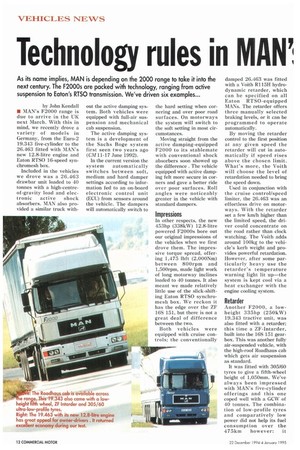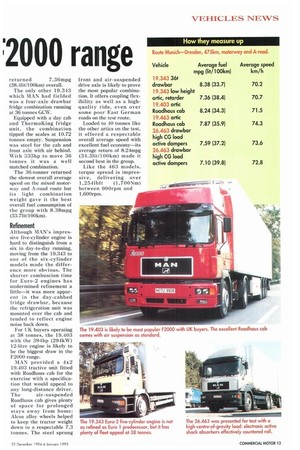Technology rules in MAN' 2000 range
Page 14

Page 15

If you've noticed an error in this article please click here to report it so we can fix it.
As its name implies, MAN is depending on the 2000 range to take it into the next century. The F2000s are packed with technology, ranging from active suspension to Eaton's RTSO transmission. We've driven six examples...
by John Kendall • MAN's F2000 range is clue to arrive in the UK next March. With this in mind, we recently drove a variety of models in Germany, from the Euro-2 19.343 five-cylinder to the 26.463 fitted with MAN's new 12.8-litre engine and Eaton RTSO 16-speed synchromesh box.
Included in the vehicles we drove was a 26.463 drawbar unit loaded to 40 tonnes with a high-centreof-gravity load and electronic active shock absorbers. MAN also provided a similar truck with out the active damping system. Both vehicles were equipped with full-air suspension and mechanical cab suspension.
The active damping system is a development of the Sachs Hoge system first seen two years ago (CM11-17 June 1992).
In the current version the system automatically switches between soft, medium and hard damper settings according to information fed to an on-board electronic control unit (ECU) from sensors around the vehicle. The dampers will automatically switch to the hard setting when cornering and over poor road surfaces. On motorways the system will switch to the soft setting in most circumstances.
Moving straight from the active damping-equipped F2000 to its stablemate with conventional shock absorbers soon showed up the difference . The vehicle equipped with active damping felt more secure in corners and gave a better ride over poor surfaces. Roll angles were noticeably greater in the vehicle with standard dampers.
Impressions
In other respects, the new 453hp (338kW) 12.8-litre powered F2000s bore out our original impressions of the vehicles when we first drove them. The impressive torque spread, offering 1,475 lbft (2,000Nm) between 800rpm and 1,500rpm, made light work of long motorway inclines loaded to 40 tonnes. It also meant we made relatively little use of the slick-shifting Eaton RTSO synchromesh box. We reckon it has the edge over the ZF 16S 151, but there is not a great deal of difference between the two.
Both vehicles were equipped with cruise controls; the conventionally damped 26.463 was fitted with a Voith R115H hydrodynamic retarder, which can be specified on all Eaton RTSO-equipped MANs, The retarder offers three manually selected braking levels, or it can be programmed to operate automatically.
By moving the retarder control to the first position at any given speed the retarder will cut in automatically if speed rises above the chosen limit. What's more, the Voith will choose the level of retardation needed to bring the speed down.
Used in conjunction with the cruise control/speed limiter, the 26.463 was an effortless drive on motorways. With the retarder set a few km/h higher than the limited speed, the driver could concentrate on the road rather than clock watching, The Voith adds around 100kg to the vehicle's kerb weight and provides powerful retardation. However, after some particularly heavy use the retarder's temperature warning light lit up—the system is kept cool via a heat exchanger with the engine cooling system.
Retarder
Another F2000, a lowheight 335hp (250kW) 19.343 tractive unit, was also fitted with a retarder; this time a ZF-Intarder, built into the 16S 151 gearbox. This was another fully air-suspended vehicle, with the high-roof Roadhaus cab which gets air suspension as standard.
It was fitted with 305/60 tyres to give a fifth-wheel height of 1,050mm. We've always been impressed with MAN's five-cylinder offerings and this one coped well with a GCW of 40 tonnes. The combination of low-profile tyres and comparatively low power did not help its fuel consumption over the 475km however: it returned 7.36mpg (38.41it/100km) overall.
The only other 19.343 which MAN had fielded was a four-axle drawbar fridge combination running at 36 tonnes GCW.
Equipped with a day cab and ThermoKing fridge unit, the combination tipped the scales at 10.72 tonnes empty. Suspension was steel for the cab and front axle with air behind. With 335hp to move 36 tonnes it was a well matched combination.
The 36-tonner returned the slowest overall average speed on the mixed motor way and A-road route but its light combination weight gave it the best overall fuel consumption of the group with 8.38mpg (33.71it./100km).
Refinement Although MAN's impressive five-cylinder engine is hard to distinguish from a six in day-to-day running, moving from the 19.343 to one of the six-cylinder models made the difference more obvious. The shorter combustion time for Euro-2 engines has undermined refinement a little—it was more apparent in the day-cabbed fridge drawbar, because the refrigeration unit was mounted over the cab and tended to reflect engine noise back down.
For UK buyers operating at 38 tonnes, the 19.403 with the 394hp (294kW) 12-litre engine is likely to be the biggest draw in the F2000 range.
MAN provided a 4x2 19.403 tractive unit fitted with Roadhaus cab for the exercise with a specification that would appeal to any long-distance driver.
The air-suspended Roadhaus cab gives plenty of space for prolonged stays away from home; Alcoa alloy wheels helped to keep the tractor weight down to a respectable 7.3 tonnes. The steel sprung front and air-suspended drive axle is likely to prove the most popular combination. It offers coupling flexibility as well as a highquality ride, even over some poor East German roads on the test route.
Loaded to 40 tonnes like the other artics on the test, it offered a respectable overall average speed with excellent fuel economy—its average return of 8.24mpg (34.314/100knr) made it second best in the group.
Like the 463 models, torque spread is impressive, delivering over 1,2541bft (1,700Nm) between 900rpm and 1,60Orpm.




















































































































